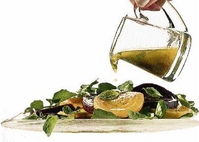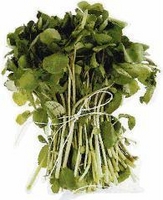Watercress: The anti-cancer super food
Published: Saturday | July 25, 2009

You may have see green, leafy plants growing wild, submerged or floating in cool, running waterways like brooks, marshes and streams and you may be at a loss as to what they are.
These are hardy perennials which thrive in clear, cold water and are officially known as Nasturtium officinale, which is a member of the mustard family known for a peppery, tangy flavour. Of European origin, the watercress is widely naturalised in North America, Canada, the West Indies and South America. According to the Collins Dictionary, watercress is an Old World plant with small, crisp, dark green leaves giving it its distinctive look.
Essential nutrients
Watercress has been known since ancient times for its 15 essential nutrients, including vitamin C, folic acid, iron, vitamin A and calcium, providing super health-giving properties, both as food and medicine. Watercress was formerly used as a domestic remedy and against the dreaded scurvy caused by vitamin C deficiency.
The delicate, light green, pepper-flavoured leaves of watercress are rich in vitamin C. Gram for gram, watercress contains more vitamin C than oranges, more calcium than milk, more iron than spinach and more folate than bananas.
Cancer prevention
Daily consumption of watercress helps protect against DNA damage to blood cells which could reduce the risk of cancer. According to an article published in the American Journal of Clinical Nutrition [18-02-07], research showed that, in addition to reducing DNA damage, a daily dose of watercress increased the ability of cells to further resist DNA damage that may be caused by free radicals.
In the study, 60 men and women, half of whom were smokers, consumed their usual diet plus 85 grams of raw watercress daily for eight weeks. Blood samples were analysed for plasma antioxidant status and DNA damage in lymphocytes, a type of white blood cell. Watercress consumption significantly reduced lymphocyte count. Intake of cruciferous vegetables such as watercress, broccoli and cabbage is associated with a lower risk of numerous cancers including bowel cancer (medicalnewstoday.com).
Medical uses
Watercress has long been used to treat sore throat and stuffy nose, but recent research suggests that it may have a much more vital use: preventing cancers of the throat and lungs in smokers.
The carcinogen in tobacco most likely contributes to the aetiology of lung cancer, as well as of mouth and throat cancers.
Chewing watercress releases the compounds that counteract the carcinogen in tobacco smoke. Taking a watercress capsule will not have the same anti-cancer effect on smokers.
Strengthening the thyroid gland due its high iodine content.
An old and effective cure for eczema and dermatitis uses an infusion of watercress.
The whole plant, slightly crushed, is used as a poultice on abscesses or closed cysts to help them heal. The sap is used on an infected wound.
Detoxifying the body by eliminating accumulated fluids in the body tissues such as in gout or for clearing mucus congestion from the lungs.
A tea is made by steeping one tablespoon of chopped watercress in a cup of boiling water for 20 minutes. Strain and drink.
Herbalists use watercress tea to tone the liver and cleanse the blood. Considered a diuretic, watercress is believed to aid in breaking up gallstones or kidney stones.
Eating fresh watercress leaves is used to treat acne, ringworm, rashes and similar skin infections and irritations.
More contemporary uses over the world include aphrodisiacs, contraceptives, laxative, cough medicine, asthma treatment, as well as for complexion and spots on the skin. (herbs2000.com)
Keeping crisp
Watercress is available year-round and is customarily sold in small bouquets. Choose crisp leaves with deep, vibrant colour without signs of yellowing or wilting. Refrigerating in a glass of water, stems down, covered with a plastic bag, will extend the shelf life for up to five days. Wash and shake-dry just before using. Watercress may become bitter when the plants start to flower, like other plants in this family.
Watercress is commonly used in commercially prepared vegetable juices and may be used in salads, sandwiches, soups and a variety of cooked dishes. It is also a popular garnish, fast replacing the overused parsley. (Watercress.com).
Menu ideas using watercress
Falafel in Pita Pockets
Mediterranean Stuffed peppers
Thai-style Beef and Watercress Salad
Warm New Potato, Roast Chicken and Avocado Salad with Watercress and Lemon Dressing
Fresh watercress or parts dried above ground may be used. Dried watercress may be added to food or infused as a tea. Watercress is very seldom found as an extract.
In former days in several households, potatoes were a staple and were used in salads. Hot salads were often served warm, creating the advantage of not having to wait until the potatoes cool and it provides warmth during winter. Watercress, a cool-weather green, adds a bright bite to this mellow dish.
Stir-fried chicken with watercress
1. In a small bowl, whisk chicken stock with black bean sauce, sherry, sugar, chili-garlic sauce and cornstarch.
2. Heat a large wok or skillet until very hot. Add 2 tablespoons of vegetable oil and heat until just smoking. Season chicken with salt and pepper and add it to the wok in a single layer. Cook over high heat, turning once, until chicken is browned but not cooked through, 4 to 5 minutes. Transfer the chicken to a plate and pour off fat in wok.
3. Add 2 tablespoons of oil to wok. Add ginger and stir-fry until fragrant, about 30 seconds. Add watercress and snow peas and stir-fry until bright green and crisp- tender, 2 to 3 minutes.
4. Return the chicken and any accumulated juices to the wok. Stir the sauce, and then add it to the wok and simmer, stirring, until thickened, about 5 minutes. Transfer to a bowl and serve with rice.
Serves 4
(foodandwine.com/recipes)

Getting creative could mean using molasses dressing to add flavour to beet and watercress salad.
Heather Little-White, PhD, is a nutrition and lifestyle consultant in Kingston. Send comments to saturdaylife@gleanerjm.com or fax 922-6223.
